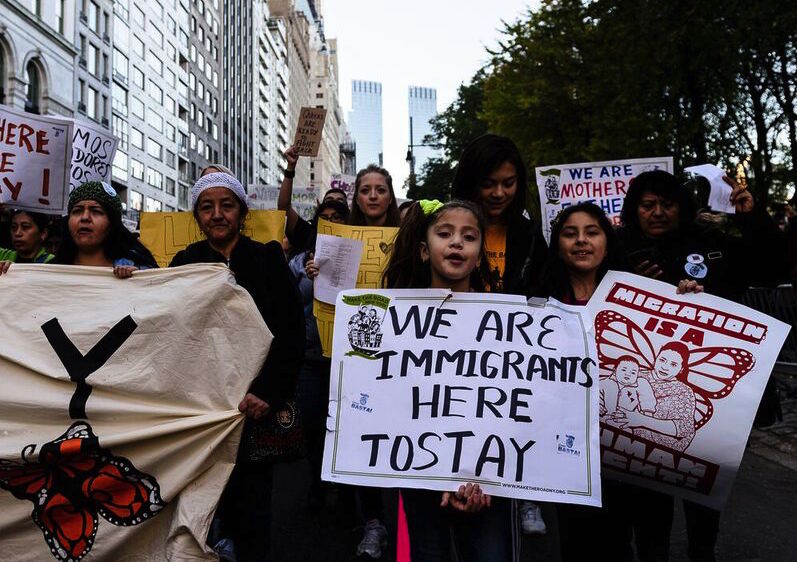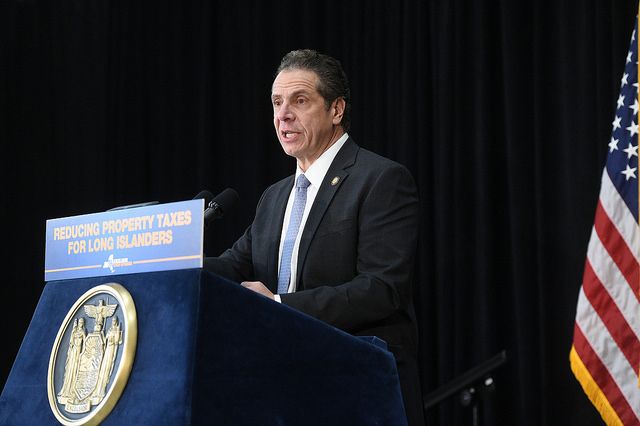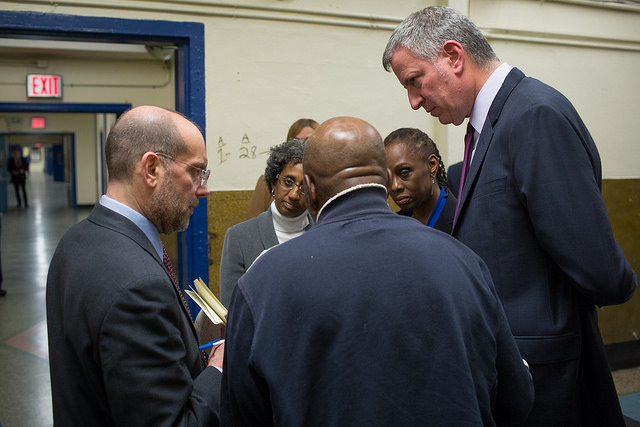Our Families Are Under Attack, So We Rise Up

I came to this country at the age of two. I have grown up in this country for over two decades, and I am a New Yorker through and through. New York City is where I go to school, where I work, and the place my family and I call home.
But my life here, and my family’s life, is at risk because I am a “Dreamer.” My only protection from being separated from my family is Deferred Action for Childhood Arrivals (DACA).
Donald Trump’s administration has already started trying to tear apart families like mine, including detaining Dreamers like me. Daniel Ramírez, a Dreamer, was detained in Washington. Daniela Vargas, also a Dreamer, was detained in Mississippi. Whether or not Trump decides to repeal DACA, it is clear that our families are under attack.
But, for immigrants like me, there is one key lesson from the first months of the new administration: when we fight back, we win.
When Trump issued the Muslim and refugee ban, it was enormous grassroots opposition, coupled with legal advocacy, that blocked these policies.
When Daniel and Daniela were detained, it was a groundswell of popular support—protests, petitions, and more—that got them free.
When Trump and Paul Ryan tried to repeal the Affordable Care Act and take health insurance away from tens of millions of people, it was ordinary people taking to the streets, town halls, and congressional offices that defeated them.
Despite these early losses, Trump shows no signs of slowing down his anti-immigrant agenda. Having failed to pass healthcare reform, Trump now wants to pass a budget that will allow him to build a wall that we don’t need and spend billions more to terrorize our families. But our communities will defeat his wall and his budget in the same way we’ve beaten him on his other priorities: by taking to the streets.
That’s why, on Monday May 1, at 5pm in Foley Square, I’m joining a coalition of dozens of immigrant, community, and labor organizations to rally for immigrant rights and workers’ rights.
On May 1, whether you were born here or in another country, whatever you believe in or however you got here—we need to stand together and resist together. With 50,000 people packed into Foley Square, we will demand that Trump stop his unjust attacks towards our communities.
Immigrant families are under attack. Workers’ rights are in jeopardy. And Muslims and refugees are in the crosshairs of this administration. Together, we will send a strong message of resistance against Trump’s agenda of hate.
As immigrants, we demand a stop to Trump’s anti-immigrant policies that are separating families throughout the nation and seeking to terrorize us all.
As workers, we demand good jobs, the right to organize and join a union, and for Congress to pass a federal budget that reflects our priorities.
As New Yorkers, we demand respect and dignity for all.
On May 1, with 50,000 people in the streets, we will show that we will not live in fear and that we stand united for a better future for all New Yorkers.
***
Yatziri Tovar is a Youth Power Project member of Make the Road New York, the largest grassroots community organization in New York offering services and organizing the immigrant community. On Twitter: @maketheroadny.
***
Have an op-ed idea or submission for Gotham Gazette? Email This email address is being protected from spambots. You need JavaScript enabled to view it.
Déjà Vu in Cuomo's Highlight Accomplishments from New Budget

Gov. Cuomo (photo: Kevin P. Coughlin/Governor's Office)
Governor Andrew Cuomo's April 10 announcement on the passage of the state budget cited several new initiatives and innovations that were included in the budget bills for the new 2017-2018 fiscal year, which began April 1.
But history suggests that at least three of them actually are not really new.
Tuition-free SUNY and CUNY
"With the 2018 Budget, New York leads the nation by making college tuition-free at SUNY and CUNY two- and four-year colleges for working and middle-class families making up to $125,000 per year," says the governor's announcement.
That sounds like a major step forward. Actually, it is something of a reversion to the original philosophy of the two public university systems. SUNY, established in 1948, was created in part as a result of the rising cost of higher education after World War II. Its units were mostly tuition-free or very low tuition until the 1960s. CUNY, established in 1961, was mostly tuition-free or low tuition until 1976. The tuition-free policy was discontinued that year as a result of New York City's fiscal crisis.
But since then, state and federal grants have been available to help low-income students at CUNY as well as at SUNY. The new policy at least partly hearkens back to policies and ideals of the past rather than departing from them.
"Raise the Age"
"The FY 2018 State Budget raises the age of criminal responsibility to 18-years-old and ensures that young people who commit non-violent crimes receive the intervention and evidence-based treatment they need," notes the governor's announcement. "New York was previously one of only two states in the nation that automatically processed all 16- and 17-year-olds as adults in the criminal justice system, no matter their offense."
The governor is certainly right in calling attention to this as a major reform. He deserves credit for its enactment. But proposals to raise the age date back quite a ways. As Governor Cuomo's Commission on Youth, Public Safety and Juvenile Justice noted in its 2014 report, Recommendations for Juvenile Justice Reform in New York State, which advocated for the change, most states raised the age many years ago. New York was one of the few states not to take this step despite criticism from youth advocates, recommendations from its own State Crime Commission in a report dating from 1931, and other experts.
Shrinking local government
"The FY 2018 Budget continues the Governor's efforts to relieve the property tax burden and builds on the success of the 2 percent property tax cap," says the Governor's announcement. "The typical New York homeowner pays 2.5 times more in local property taxes than in state income taxes. The Budget will empower citizens to control the cost of local government by requiring counties to assemble local governments to find efficiencies for real, recurring taxpayer savings. To ensure transparency and an active role for citizens in reducing their tax burden, public hearings and input will be required as part of the development of the shared services plans."
New York has about 4,000 local governments. The governor's initiative is a fresh variation on an old theme: reducing the number of local governments, consolidating them, or urging them to share services in order to reduce the burden on taxpayers.
History suggests Governor Cuomo's new initiative may have a hard time getting traction.
New Yorkers may complain about taxes, but they seem indifferent to state initiatives to eliminate or consolidate services. Consolidation threatens the jobs of local officials. Citizens are apprehensive about changing something that is familiar even if it means greater efficiencies and more economical operation.
In 2013, Cuomo offered a program of state support to promote reduction of local governments through consolidation. There was little interest.
Governor Eliot Spitzer appointed a Commission on Local Government Efficiency and Competitiveness.
Governor George Pataki had a Commission on Local Government Reform.
Governor Mario Cuomo appointed a Commission on Consolidation of Local Governments.
None made any appreciable headway.
In 1935, Governor Herbert Lehman told the Legislature that "There are too many units of government in the State of New York and...the resulting complexity of local government cannot produce efficiency or economy." Legislators were not interested.
In 1929, Governor Franklin Roosevelt asserted "even the school children know that we maintain many useless offices in our towns, that many functions now exercised by town officials should be assumed by county management...in the final analysis...the average taxpayer does not know why or where his tax money is being spent." In 1932, he cited "great waste and duplication" and "thoroughly unbusinesslike practices." But even then, with the Great Depression undermining local governments' tax base, very little happened.
In 1926, Governor Alfred E. Smith, who had reorganized and consolidated state government, called New York's complicated system of local government "costly, wasteful and obsolete...we have too many political divisions, too many officials, too little efficiency." The pattern of counties, cities, and towns had changed little since the beginning of the state. Over the years, special districts for sewers, water, etc., "were created without any understanding of the results that would follow because they overlap one on the other and set up within one township all sorts of overlapping special governments and special tax districts."
Two years later, Smith said the sprawling system of local governments represented "the old-fashioned, foolish way of doing things...inefficiency...we are still in the Middle Ages of government."
Among Smith's proposals: abolish the five counties in New York City; elevate densely populated Nassau County to the status of a city; merge Dutchess and Putnam counties, Rensselaer and Columbia counties, and Warren, Washington, and Saratoga counties into three large counties.
Smith made a strong case: consolidation would save taxpayer money, improve services, make government more responsive, and streamline management of state aid for highways, welfare, and other services.
But Smith's proposals produced very little public interest and support. The Legislature declined to take any action.
There may be more action under Cuomo's new approach. But history does not offer much cause for optimism.
These three examples suggest that looking back into history can often help inform current policy discussions. Often, there are reverberations of past policy proposals in innovative new ones.
***
Dr. Bruce W. Dearstyne's latest book is The Spirit of New York: Defining Events in the Empire State's History, published in 2015 by SUNY Press.
***
Have an op-ed idea or submission for Gotham Gazette? Email This email address is being protected from spambots. You need JavaScript enabled to view it.
A Smart Move for Homeless Families, Neighborhood Residents and City Taxpayers

Mayor de Blasio visits Bellevue Men's Shelter (photo: Michael Appleton)
Residents of Manhattan’s Kips Bay neighborhood have been plagued in recent years by crimes attributed to clients of the 800 bed men’s shelter on East 30th Street and First Avenue.
Shelter clients have reportedly defecated in front of buildings, publicly masturbated, and exposed themselves to children in windows of classrooms. Since the shelter does not prohibit violent parolees or other criminals, neighborhood residents, as well as proprietors and customers of nearby businesses, have reported being raped, robbed, assaulted and stabbed by shelter clients. Fugitives and child sexual predators have hidden among shelter clients and, just recently, a man was arrested outside the shelter for alleged heroin sales.
Neighborhood residents are mindful of the homelessness crisis, and have willingly carried their share of the city’s burden for decades. But they also desire to preserve their quality of life and the safety of their community. They have long requested that the 30th Street shelter be re-purposed as a shelter for homeless families instead of single men.
A recent confluence of events should inspire the de Blasio administration, the city’s Economic Development Corporation (EDC), and Governor Cuomo to consider their proposal. It makes good sense for homeless families, city taxpayers, and the city’s budget watchdogs. As the mayor continues to roll out his new shelter plan, he should incorporate these ideas.
Consider these three developments:
1. Covenant House, the sanctuary for homeless youth, and the EDC have proposed development of the block containing its West Side headquarters, between West 40th and 41st Streets, Ninth and Tenth Avenues.
2. Governor Cuomo’s proposed budget released January 17 called for the sale of the Hunter College Masters of Fine Arts building on the Covenant House block so that “up to $60 million of the proceeds” can be used to fund the budget of the City University of New York.
3. City Comptroller Scott Stringer reported that New York City spent nearly $73 million on hotels for homeless families in the twelve months ending last October 31, sometimes paying as much as $600 per night for a room.
Housing homeless men in new or existing buildings on the Covenant House block on the West Side would free up the 30th Street men’s shelter for homeless families now housed at expensive Manhattan and outer-borough hotels. It would also offer an array of other benefits.
Any vacationer who has had to spend a night or two stuck at an airport hotel with young children knows how desolate they can be for youngsters. There is no play space, inside or out; no entertainment besides TV; and no real stimulation. Meals are limited to room service, the hotel restaurant, or take-out or delivery from a poor array of choices. Children are understandably “bouncing off the walls” within a few hours.
But New York’s homeless families can be left in hotel settings for weeks and months at a time. On average, the city’s homeless families spend over 400 days in shelter before being moved to permanent homes.
A family-oriented homeless shelter at East 30th Street would allow homeless children access to common play and study space, nutritious institutional dining with other families, and parks, schools, churches, libraries, and the healthcare facilities of Kips Bay. They could be spared the social isolation that comes with living in a hotel and, instead, be integrated into a community of similarly situated children, as well as those of the neighborhood. Moreover, their parents could have ready, free, day-care in the shelter while getting help or finding a job.
Temporarily housing homeless men on the Covenant House block would place them in a largely commercial district near hotels and other transients. The city could consolidate social services for Covenant House clients, men’s shelter clients, and out-of-shelter homeless people who congregate near Port Authority Bus Terminal. Locating the men’s shelter near the NYPD stronghold of Times Square and near the borders of three police precincts would better deter criminal activity.
The Covenant House/EDC proposes their development include some affordable housing. But the site lays near the Lincoln Tunnel entrance and adjoins the PATH bus terminal ramp. It’s desolate and mostly unsuited to permanent housing; EDC should look elsewhere for affordable permanent residences. But it is a much better locale for temporarily housing homeless men than the bustling residential neighborhood of Kips Bay.
While it will certainly be necessary to renovate both the 30th Street shelter and the Hunter College building (or to build a new building, as Covenant House proposes), the savings from placing 200 to 300 homeless families in a community shelter instead of costly Manhattan hotels would recover those costs in just a few years and generate tens of millions in cost savings prospectively.
The de Blasio administration, Governor Cuomo, and the EDC should move thoughtfully and creatively on the Covenant House site. They have a rare chance to do good for homeless families and the residents of Kips Bay, and to do well for the taxpayers of New York.
***
Lauren Pohl, an attorney, is the founder of Kidz Central Station. Thandi Gordon Stein-Sapir is a fashion industry executive. Both are leaders of Third and 33rd, a group that advocates for neighborhood safety and improvement.
***
Have an op-ed idea or submission for Gotham Gazette? Email This email address is being protected from spambots. You need JavaScript enabled to view it.




